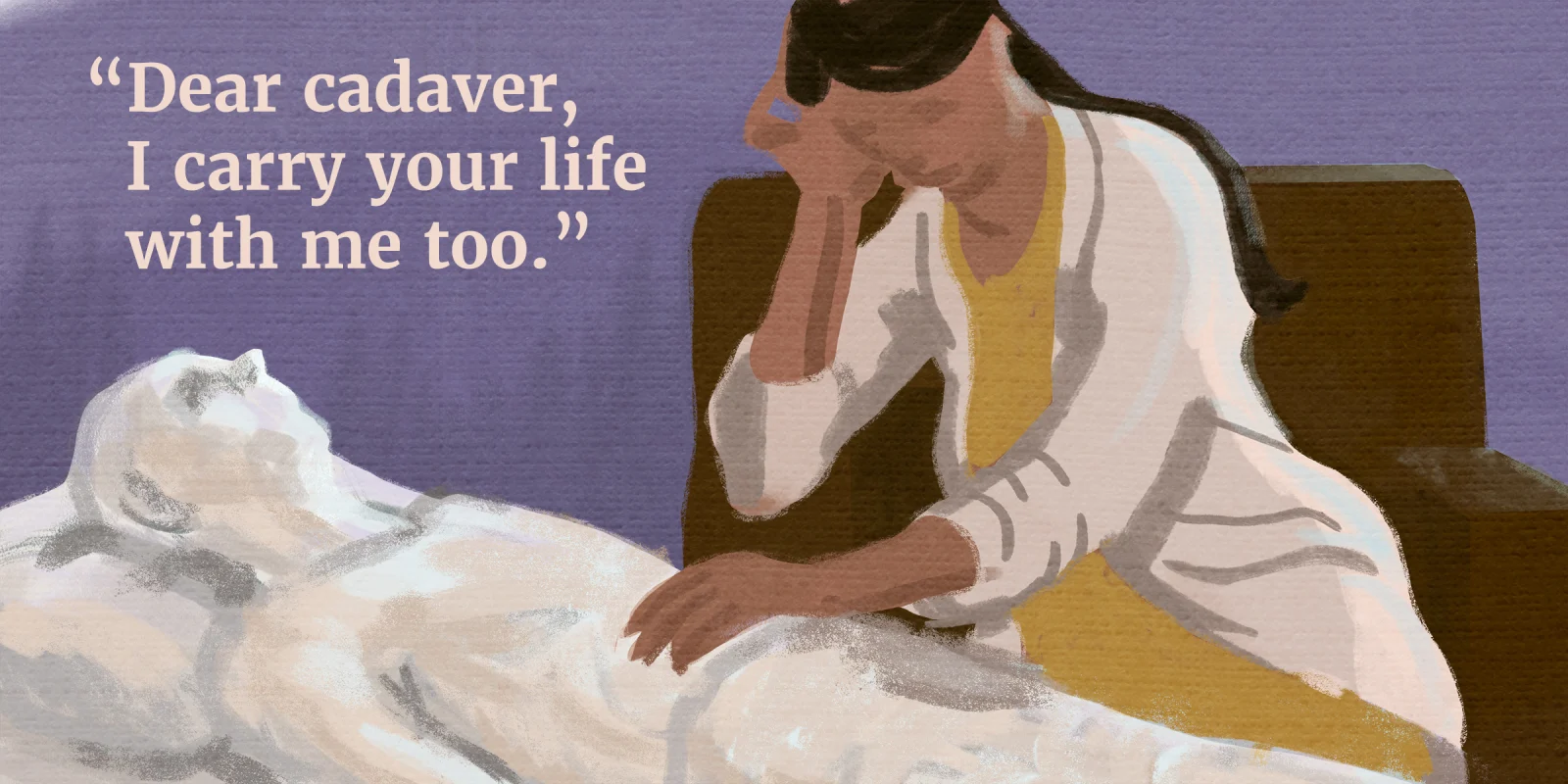This is part of the Medical Humanities series on Op-Med, which showcases creative work by Doximity members. Do you have a creative work related to your medical practice that you’d like to share? Send it to us here.
Touching the exposed muscles and tendons with my guarded, gloved hands felt like an intrusion. The irony did not escape me as I glanced at the rib cage that I had removed earlier that week to visualize the heart. I had occupied the chest cavity, fitting my limbs into a body that was not my own and wrapping my mind around the tangle of vessels arriving and departing the heart the way train tracks screech to a stop at a connecting station.
The sophistication of the heart was not lost on me, but I could safely appreciate it with the distance of an estranged parent. Yet, it only took the subtle brush of blue latex on bare fingers to transport me to an intimate familiarity. I was time traveling without having seen the itinerary.
Dusty handprints desecrating the cream-colored leather couch I was warned not to touch, I trace the edges of the pinky finger hesitantly, trying to figure out how damning the evidence is. Mama does not need a database to cross-check fingerprints — she takes pride in knowing every palm line on her children. I decide to confess, like a prisoner hoping to get off for good behavior. I brace, expecting anger. Instead, I am rewarded with laughter as she cups her hand over mine over the offending print the way measuring cups of increasing size fit perfectly within each other.
Who held your hand when you were a child? I hope their grip was as supple as the soles of a newborn, as warm as bread right out of the oven, as loving as the doting gaze Mama gave me that day.
Her body is crumpled under pink Princess Ariel blankets. She insisted we bring them to the hospital between the screams the pain allowed, when it gave her a brief reprieve. The nurse tells me not to touch her, in case I disrupt the drip, drip, drip of the IV. I don’t tell her that’s exactly what I want to do after watching her skin rot to a yellow color, then purple, the shade of sick blood. As soon as the nurse leaves the room, I gingerly lace my fingers between the gaps in hers. Our tightly intertwined hands ground fear into dust, smaller pieces easier to overcome.
Was the IV kinder to your skin than it was to her? It is OK if it wasn’t, because after holding my sister’s hand for a while, the gold in her soul eclipsed the bruises.
My grandmother read my palm like she was gleaning the secret to everlasting life. I sat quietly and impatiently until the whites of her eyes expanded in surprise. At that point, I could barely be expected to hold my tongue or any other part of my body for that matter. She told me she saw a full life in the smiling creases of my skin. Abundant in laughter, hardship, love, pain, adventure. I asked her how she knew. She simply held her palm against mine, showing me that they were mirror images. A promise that at the very least, I carried her life with me.
I suppose now, dear cadaver, I carry your life with me too.
What was your inspiration? Did other creative works, if any, influence your creation of this piece?
Although most of my medical school classes were virtual, we were still able to attend anatomy lab this semester. I expected to learn a lot about the human body from the selfless donors who made themselves available to us, but I did not expect the repressed memories of lost and loved ones the cadavers would encourage me to unearth and relive. To honor that urging, I wrote this piece.
Why did you choose this medium? What interests you about it?
The piece is written in a form I would call poetic prose. I chose it because it allows me to construct vivid images of dissection alongside vignettes of my life, but also, there is a rhythm and lyricism in the words that acts as a second conduit for emotion, in the same way good music makes you feel just through its melody.
How long have you been doing this activity? What got you started?
I have written poems and short stories ever since I could hold a pencil. I was quite introverted as a child, so I used written words to make my thoughts tangible through narratives on a page. I enjoy coming across previous work I have written – it is like seeing snapshots of my mind over time. Now I can conserve these snapshots as I learn and grapple with what it means to experience medical training.
Vongai Mlambo is a first-year medical student from Zimbabwe at Stanford University. Her academic interests include global health and educational equity. Whenever she can, she spends time weaving stories, hiking, and baking bread from scratch.
Illustration by Jennifer Bogartz





